Summary of Northern European Renaissance
While Italy was witnessing the revival of classical antiquity and the development of humanism in the 15th century, Northern Europe (present day Belgium, Luxembourg, Netherlands, Germany, Austria, Switzerland, and France) similarly experienced a flourishing of artistic production.
The Northern Renaissance has its roots in the Gothic tradition and the lavish court art sponsored by the dukes of Burgundy, who controlled regions of present-day France and the Low Countries (Belgium, the Netherlands, and Luxembourg). In the 1420s, artists from these areas began to create oil paintings that were remarkable for their illusionism and naturalistic representation.
In the following century, the Protestant Reformation greatly influenced the production of art. With its rejection of certain types of religious images, the Reformation inspired artists to develop new genres of artwork that depicted elements of daily life. While artistic patronage had traditionally been centered around the Church and aristocracy, the rising merchant class began to play an important role in art production in the North, especially with the growth of urban centers and the development of a robust art market.
Key Ideas & Accomplishments
- During the Northern Renaissance, artists such as Jan van Eyck and Robert Campin developed and perfected the medium of oil painting, which was used to produce altarpieces, devotional works, and portraits. Their paintings, as well as those by Rogier van der Weyden, Hans Memling, and Gerard David, are remarkable for their illusionism, attention to detail, and emphasis on materiality.
- During the late 15th and early 16th centuries, Northern artists, many of whom traveled to Italy, created paintings that, for the first time, combined regional traditions with elements taken from the Italian Renaissance, such as architectural forms and imagery from classical antiquity. In doing so, these artists created completely new, hybrid painting styles that helped spread Italian Renaissance culture throughout Northern Europe.
- The Protestant Reformation not only addressed the vices and corruption of the Catholic Church, but also promoted man's ability to maintain a direct connection with God through prayer and scripture, without mediation from the church. The Reformation had a major influence on the arts, as artists adapted their subject matter and styles to match new theological attitudes towards religious images.
- The growing popularity of printmaking in Northern Europe allowed images to be mass-produced and widely available to the public. With the invention of the printing press, Protestant reformers were able to bring theology to the people through books and pamphlets on a large scale; in many instances, artists collaborated with authors and publishers to illustrate these printed books.
- Northern European artists began to explore new genres of paintings that emphasized scenes and subjects from daily life, many of which were given a moralizing undertone. These new categories of painting included landscape, portrait, animal, still life, and scenes of everyday life (also known as genre painting).
Artworks and Artists of Northern European Renaissance
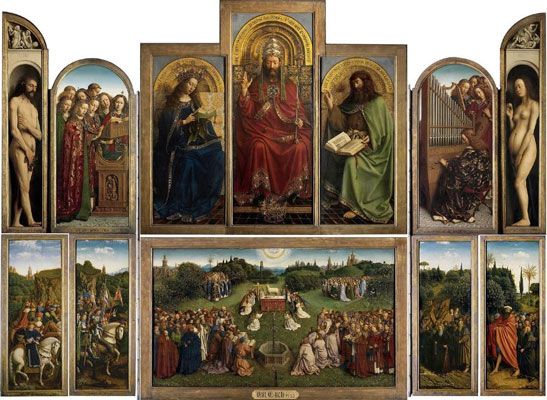
Ghent Altarpiece
This renowned polyptych, painted on both sides, creates a naturalistic divine world illustrating an epic swath of biblical narratives. The work's symbolic iconography is complex and mysterious. For instance, it is questioned whether the central figure in the upper panel who is raising two fingers in blessing is Christ as Divine King or God the Father, for Christ has already been alluded to as the lamb in the lower central panel, referencing the Adoration of the Mystic Lamb, with a dove, representing the Holy Spirit, visible above him.
In the upper left panel, the Virgin Mary, her gaze upon the sacred book she holds, evokes both traditional depictions of the Annunciation and the era's Protestant emphasis that an individual can connect directly to God through the reading of sacred texts. This concept is again depicted in the upper panel where St. John the Evangelist looks toward Christ, raising his right hand, while holding an open book resting on his knee. At the far end of both wings, Adam and Eve are depicted nude, Adam's arms covering his body, while Eve partially shields herself while holding an apple in her right hand. They are almost sculptural, and their precisely rendered expressions and body language, inhabiting an empty and narrow black space, convey a sense of penitence. The two are separated from the central trio by panels that depict angels engaged in song on the left, and a group of angels gathered around one playing a harp on the right. The wing's lower left panels depict the Just Judges and the Knights of Christ. On the right, a group of pilgrims and hermits, led by St. Christopher, move toward the central image of the Christ lamb. In a wide green landscape, with mountains and city towers in the distance, the linear perspective draws all eyes toward the Lamb, as a multitude of people, including notable religious figures, saints, angels, ancient philosophers, and scholars, gather to worship. The image visually expresses "After this I beheld...a great multitude, which no man could number, of all nations, and kindred, and people, and tongues, stood before the throne, and before the Lamb." The population and complexity of the painting is profound, and as art critic Noah Charney noted, "It's easy to argue that the artwork is the most influential painting ever made: it was the world's first major oil painting, and...It's almost an A to Z of Christianity- from the annunciation to the symbolic sacrifice of Christ, with the "mystic lamb" on an altar in a heavenly eld, bleeding into the holy grail."
Both van Eyck brothers are credited with the work, as it's believed that Hubert initially designed the altarpiece, while Jan painted the panels and completed it. The mayor of Ghent Jodocus Vijd and Lysbette, his wife, commissioned the work for Saint Bavo Cathedral. The largest work in van Eyck's oeuvre, this is also the only work he created for a public audience.
Even though all of the religious imagery was widely drawn from tradition, it was profoundly innovative for its time due to van Eyck's masterly use of oil and realism, as seen in every detail right down to the pearls bedecking Mary's dress, each one a drop of grey with a single touch of white to create an iridescence. Van Eyck's precise observation is also evident in the singing angels, as musical scholars have been able to identify the note each angel is singing by the shape of the mouth. As Peter Schjeldahl, the contemporary art critic wrote, "His style is synthetic, a repertoire of nesses - some derived from manuscript illumination, which was then the most common mode of painting, and some from the advanced modeling of bodies and drapery found in the sculpture of the time...nothing beats the bristling inventiveness of the Ghent Altarpiece."
At the time the altarpiece was unveiled, it was hailed as not only a masterpiece, but also the singular work that epitomized the spirit and genius of Northern Europe. As a result of that status, the work has been stolen and recovered countless times. The panel on the lower left is a later copy, made to reproduce the stolen original, a theft still under investigation after decades.
Schjeldahl wrote, "Historically, it is a clutch of firsts: it represents the first really ambitious and consummate use of oil paint... and it marks the birth of realism as a guiding principle in European painting.... nothing that we know of anticipated the eloquence of van Eyck's glazes, which pool like liquid radiance across his pictures' smooth surfaces, trapping and releasing graded tones of light and shadow and effulgences of brilliant color."
Van Eyck's mastery of oil painting influenced Rogier van der Weyden and other Northern European artists of the era, as well as artists of the Italian Renaissance, and transformed subsequent Western art. The altarpiece has been referenced in movies and popular culture as seen in the book and movie Monuments Men (2014).
Grisaille, oil on wood - Saint Bavo Cathedral, Ghent, Belgium
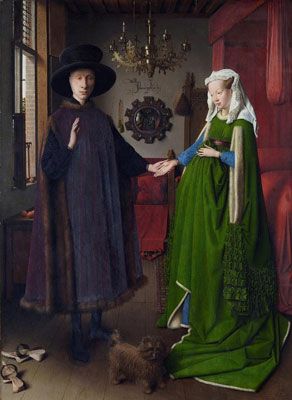
The Arnolfini Portrait
This iconic portrait shows a domestic scene of Giovanni di Nicolao and his wife in what is presumably their home. The man holds the woman's hand with his left hand and raises his right as if in a gesture of blessing as he faces the viewer. The woman gazes downward while her left hand bunches up the green fabric of her dress at her waist in a way that was in contemporary fashion of the time. A little Brussels griffon dog stands in the foreground between the couple, the texture of his bushy coat delineated in the hairs that are up around his alert expression. On the back wall, also visible between them, a convex mirror with arms depicting miniaturized and realistic scenes of Christ's passion reveals two people reflected in its depths. A strand of amber beads hangs beside the mirror on the left, and above the mirror, an inscription is written on the wall. The two figures reflected inside the mirror appear to be standing just inside the door, facing the couple. The inscription reads "Johannes de eyck fuit hic 1434" or "Jan van Eyck was here 1434" in Latin, and the figure in red, reflected in the mirror, has been taken as the artist himself. The light comes in from the open window on the left, where a single candlestick and an orange rest on the sill, creating a sense of interior spaciousness and reflecting a diffuse glow on the surfaces of the objects in the room. Between the couple a chandelier extends from the ceiling, lit up by the light, so that it resembles both an organic form and a heavenly crown.
The interior is depicted with precise observation, yet each item is also part of a complex and mysterious iconography. Scholars have interpreted the little dog both as a symbol of fidelity and of lust. The green that the woman wears may symbolize hope or the fecundity of spring. The cast-off shoes that are visible in the lower left have been taken as an allusion to standing on holy ground. The mirror's scenes of Christ's passion may suggest God's promise of salvation to the couple in the room or the couple reflected in the mirror. Even the oranges visible near the window may reflect wealth, as they were an expensive delicacy at the time. They may also suggest the Garden of Eden.
The artist's innovations include the use of a sophisticated orthogonal perspective to create the interior space. His notable vivid color palette is at play in the fine fabrics of the clothing, the bed with its red drapery, and the chair in the back, as various objects refract and reflect the direct and indirect lighting in the work. But the highest achievement of the painting is the fact, as written by art historian Craig Harbison, that it "is the only fifteenth-century Northern panel to survive in which the artist's contemporaries are shown engaged in some sort of action in a contemporary interior. It is indeed tempting to call this the first genre painting - a painting of everyday life - of modern times." As contemporary art critic Jonathan Jones also wrote, "This looks like a real world, with real people. The key to the picture is the mirror on the wall...a convex mirror, which just happens to look like a camera lens. It takes in the whole room...the mirror, so significantly placed between the couple, is an image of what this painting claims to be: a true reflection."
This painting has been widely influential as art critic Alison Cole noted, particularly "on two generations of British painters." The Pre-Raphaelites Dante Gabriel Rossetti, William Holman Hunt, and John Everett Millais particularly admired the work for its color palette, its precise oil technique, and its complex symbolism.
Oil on oak panel - The National Gallery, London
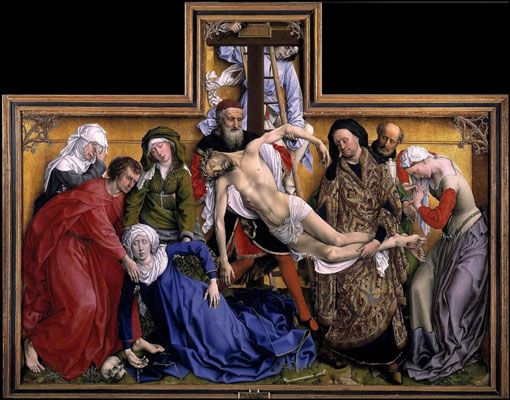
The Descent from the Cross
This dramatic religious painting depicts Jesus being taken down from the cross by three men. Anguish is visible in the scene as all the figures bow inward toward the central figure of Christ. On his left, his mother, the Virgin Mary, faints as St. John the Evangelist and Mary Salome strive to help her up. A young man in blue damask stands on a ladder behind the cross in the upper panel, his right hand gripping two extracted bloodied nails. Nicodemus, a Pharisee, his brow lined with introverted sorrow, stands behind Jesus, holding his torso in his arms. Joseph of Arimathea, dressed in a robe patterned with gold, cradles Christ's legs. On the far right, Mary Magdalene contorts her entire body as she wrings her hands, while Mary Cleophas at the upper left buries her face in her hands.
The remarkably condensed and compressed scene is full of movement, driven by the figures animated with emotion. Sorrow and grief mark every face.
The work also condenses layers of symbolic meaning, as the skull at St. John's feet alludes to the Hill of Golgotha, and the red clothing with its revealing neckline worn by Mary Magdalene alludes to a fallen woman. The blue damask and elevated position of the young man on the ladder suggest an angelic presence. At the upper left and right, two small crossbows symbolize the Great Crossbowmen's Guild that commissioned this work for the Chapel of Our Lady Outside the Walls at Leuven.
Van der Weyden ignored anatomical accuracy for both emotional effect and to create a convincing spatial illusion. He lengthened the Virgin's left leg, so her mantle cloaks the base of the ladder and the cross. He distorted some of the figures, as seen in Magdalene's arm wringing and the horizontal axis of Christ`s head, to convey the emotional contortions of a terrible event. His use of primary colors, his realistic facial expressions, and his fluid line, emphasizing the movement of the body falling to earth, were also highly original. The almost life-sized figures are sculptural and a three-dimensional effect is created by the artist's employment of false perspectives to deal with the spatial incongruity between the shape of the panel and the space he wanted his figures to occupy. The shallow box of the panel, resembling a shrine, contains five, convincingly rendered, depths of space.
Van der Weyden’s painting reflects the tenets of the Devotio Moderna, a religious movement that emphasized empathetic piety and encouraged believers to imagine themselves in the physical presence of saints, the Virgin or Christ himself. To achieve such visual choreography to convey feeling, the artist must have been sharply aware of the emotional response of the viewer in a way few artists had been before, as art critic Michael Glover wrote, "There is an almost brutal, if not harsh immediacy about the painting. This is religious drama felt on the pulses...their outrageous grief seems to burst out of the painting - there is space for nothing else."
This painting was often copied and widely influential in its own time, and Glover noted, "The way in which he distorts the figure undoubtedly had its impact upon Picasso and Matisse."
Oil on oak panel - Museo del Prado, Madrid

The Garden of Earthly Delights
Bosch's most famous triptych is The Garden of Earthly Delights, noted for its complex imaginative and startling imagery. The outer panels are intended to bracket the main central panel - between the Garden of Eden depicted on the left, and the Last Judgment depicted on the right. On the left, an unusually youthful God presents Eve to Adam. The central plane is a vast panorama, containing nude figures, exotic animals, and fantastic architectural structures, to portray Eden. The right panel depicts Hell, a world of humans who have succumbed to evil temptations and are now reaping eternal damnation. The outer face of the panel also contains images, done in grisaille, depicting God creating the world on the third day, its image echoing a 1493 print by Michael Wolgemut, and, perhaps, used to posit the entire work within its religious context.
Bosch was one of the most influential Early Netherlandish painters and although his work often interpreted a Late Gothic religious sensibility, he is most noted for a radically individualized style. In this piece, his version of hell is very different from previous treatments of the subject and could be interpreted as the "hellish" world of an individual man's own making. As art historian Joseph Leo Koerner writes, "the painting of everyday life was bound inextricably to what seems its polar opposite: an art of the bizarre, the monstrous, the uncanny."
Engelbert II commissioned the work for the Coudenberg Palace in Brussels, so while the work resembles a religious altarpiece in its structure, it was meant for a more secular and private audience. Little is known of Bosch, and this iconic work has been variously interpreted from being viewed as a visual warning on sin, lust in particular, to a depiction of a kind of paradise lost of polymorphous sexuality, as art historian Peter S. Beagle wrote, expressing an "erotic derangement that turns us all into voyeurs, a place filled with the intoxicating air of perfect liberty."
In his own era, Pieter Bruegel the Elder acknowledged Bosch as a significant influence, and a number of his works like The Triumph of Death (c. 1562) reference Bosch's landscape of hell. Giuseppe Arcimboldo's portraits, portraying people as a composition of various roots and plants, were influenced by Bosch's willingness to re-imagine another world. Bosch's work was rediscovered by the 20th century Surrealists, as The Garden of Earthly Delights influenced Salvador Dalí, Max Ernst, and René Magritte. Joan Miró's The Tilled Field (1923-1924) also contains several visual references to the painting.
Grisaille, oil on oak panels - Museo del Prado, Madrid
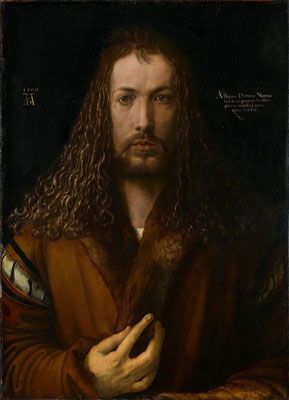
Self-Portrait
This iconic self-portrait depicts the artist, confronting the viewer with a somber and intense gaze. The unconventionally dark background, where inscriptions float on either side of him, creates a sense of charged symbolism and presents him as occupying a space that is undefined by locale and time. This results in a feeling of monumentality. And although the overall effect is of classical restraint, as art historian Marcel Brion noted, the work has "a classicism like that of Ingres. The face has the inflexibility and impersonal dignity of a mask, hiding the restless turmoil of anguish and passion within."
Dürer painted three self-portraits, of which this one, the last, is the most complex. The artist's innovations included using a frontal pose for an ordinary portrait for the first time, and, as a self-portrait it was unprecedented. The work is so vertically symmetrical that the head being subtly off center and the eyes looking to the left create a sense of kinetic movement. The color palette creates a somber mood, as the rich dark browns of the artist's coat, the light kissed long curls of his hair, and the soft fur collar, contrast with his pale skin and the inky background. For the audience of his time, this self-portrait would have primarily evoked traditional portraits of Christ. Some critics have felt that in this treatment, Dürer meant to convey the concept of the artist as divine creator.
The artist was a close friend of the Humanist scholar Conrad Celtis. Celtis's secretary wrote the Latin for the inscription visible in the upper right, which reads, "I, Albrecht Dürer of Nuremberg portrayed myself in everlasting colors aged twenty-eight years." In the upper left, the golden monograms of "A" and "D" reflect the artist's signature, but also allude to the abbreviations for "Anno Domini" and are incised under the year 1500. The work, in its emphasis upon the artist's persona, is a remarkably modern self-staging, and influenced artists in the 19th and 20th centuries. He is celebrated in the calendar of both the Lutheran and Episcopal churches, and his work led to the Dürer Renaissance (c. 1570 to 1630.)
Oil on wood panel - Alta Pinakothek, Munich, Germany
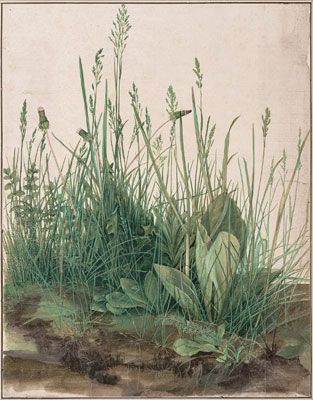
The Large Piece of Turf
This painting depicts a piece of turf containing smooth meadow-grass, dandelion, greater plantain, hound's-tongue, yarrow, germander speedwell, creeping bent, and cock's foot. The various plants, differing in shapes of leaves, flowers, and stems, and painted in varying tones of green, create a sense of the chaotic growth of nature, and contribute to the work's realistic effect. The broken ground, showing darker fissures, and the exposed roots of some of the plants, creates a sense of the earth's solidity as well as emphasizing the diagonal flow of the plants from the right where a bit of bare earth shows between the plants and the edge of the frame and extending to the left as the plants seemed to continue indefinitely. The empty background creates a kind of singular focus on the plants themselves, as if they were clearly seen outside of any particular setting or time. Each plant is depicted with scientific precision, showing why the Humanist Conrad Celtis compared Dürer's painterly observation to the work of the great medieval scientist and philosopher Albertus Magnus.
Dürer's use of watercolor was innovative, as was this large-scale focus on a bit of grass - pioneering a kind of still life. Acknowledged as one of the artist's masterworks of realistic representation, the artist undertook this work as a study, and the results informed his very detailed engravings, like Adam and Eve (1504) or Knight, Death, and the Devil (1513). This work influenced later artists like Vincent Van Gogh's Grasgrond (Patch of Grass) (1887).
Watercolor, pen and ink - Albertina Vienna, Austria

The Isenheim Altarpiece
This iconic cross-shaped altarpiece depicts a very common narrative portrayed in paintings of the time. The focus is on Christ in the central panel, as the cross vertically divides the frame, and as his agonized body with flesh turning green dominates the scene. Many of the figures are created with the realistic observation and proportion of Renaissance art, and even the cross, crudely made as if hammered together out of scrap wood, has a three-dimensional effect. On the right John the Baptist is seen holding an open Bible and pointing toward Christ, while a lamb bearing a wooden cross stands beside him. On the left the Virgin Mary in white is leaning back as if to fall, her hands clasped toward her son, while John, the beloved disciple, catches her in his arms. Mary Magdalene kneels at the base of the cross, her clasped hands outstretched toward Jesus, while a pot carrying spikenard for anointing him rests beside her. In the left wing St. Sebastian is depicted in martyrdom, pierced with arrows, and in the right wing, St. Anthony is depicted, resolutely gazing out at the viewer. In the upper right corner a demonic monster comes in through a broken window. In the predella, or bottom panel, Christ is lying beside his open tomb, his upper torso held upright by John and the two mourning women beside him.
This work was commissioned by the Monastery of St. Anthony in Isenheim, Germany, which ran a hospital for treating those suffering from "St. Anthony's Fire," an often fatal illness that has since been identified as ergotism, caused by eating fungus-infected rye. As art critic Jonathan Jones noted, "The horrific appearance of Christ's flesh on the altarpiece is not pure fantasy, but portrays symptoms the monks were trying to alleviate."
Grünewald's innovation was to combine a realistic treatment of death and decay in depicting Christ, while exaggerating his scale and proportions for profound emotional effect. Christ is larger than the other figures, his splayed out elongated arms extending upward, and his clawing fingers reaching upward into the blackened sky. As Jones wrote, the "Isenheim altarpiece is death. It is death without disguise, grotesque and terrifying."
As Jones also wrote, the work reveals "the German Renaissance culture that produced it...the Isenheim altarpiece is a German painting to its marrow - German art's Sistine Chapel, even. Grünewald's amazing sense of color allows him to transform the miserable darkness of his Crucifixion to the magical, illuminated night of his Resurrection."
This work was seen as so powerful in the religious community that the Lutheran Church acknowledged the artist as a kind of saintly figure, still celebrating him on April 6th. This work's powerful and sensational expression had a profound influence on later German artists, influencing Otto Dix and George Grosz. The altarpiece's depictions of a bird-demon beating St. Anthony with a stick was referenced in works by the Surrealist Max Ernst and Picasso did a series of drawings of the Crucifixion in 1932.
Oil on panel - Musée Unterlinden, Colmar
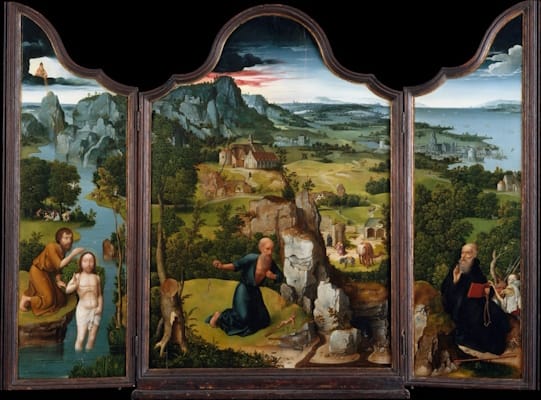
The Penitence of Saint Jerome
This triptych depicts three different religious narratives, united by a rich and varied landscape that extends in an atmospheric panorama. In the central panel, Saint Jerome is depicted kneeling before a crucifix as he flagellates his bared chest with a sharp rock in his right hand. In the left wing, John the Baptist kneels as he baptizes Christ, who wears a loincloth and stands in the Jordan River, while on the right wing the anchorite Saint Anthony reads Holy Scripture while being tormented by demons. The arm gestures of the three figures – pouring water, holding the rock of penance, lifting a hand in prayer – all point toward Christ, uniting the disparate scenes in Christian devotion. What’s emphasized as art historian Lynn Jacobs noted is “the connected nature of their anchorite experiences and unites them as exemplars of virtue and models of the monastic ideal who retreated to the wilderness to escape the sins of the city.”
These scenes are taken from Jacobus de Voragine’s Golden Legend, originally titled Legend of the Saints, first compiled between 1259 and 1266, and which became widely popular after the invention of the printing press in the 15th century. Other scenes are also depicted in the background, as John the Baptist preaches to a gathering at the edge of the forest and Saint Jerome confronts two thieves and pardons them. Additionally, the back of one wing depicts Saint Anne holding the Virgin Mary who holds the infant Jesus while the other wing depicts Saint Sebald, both sculpture-like figures rendered in grisaille and depicted as if standing in a niche.
Yet, despite the religious significance of the work, as art historian Maryan W. Ainsworth notes, “Certainly the most striking feature of the triptych, and a true novelty for its time, is the ‘worldview’ landscape that extends across all three panels. At the beginning of the sixteenth century, landscape painting began to emerge as an independent genre, and Patinir was at the forefront of this development.” She also notes the “unique features of the landscape... seen from above in a bird’s-eye view, while the individually studied components, such as the craggy rocks, buildings, and large trees, are viewed at eye level. A ‘bold defiance’ of atmospheric perspective, allowing the viewer to encounter near and far elements with equal clarity, and a high horizon line unite these disparate views to create an ideal landscape, not a realistic one.”
A painter from Antwerp, little is known about Joachim Patinir’s artistic training, though his work came to the attention of Albrecht Dürer who dubbed him, “the good landscape painter.” Patinir’s approach to landscape painting influenced subsequent artists, including Herri met de Bles, Lucas Gassel, and Pieter Bruegel the Elder, who transformed the world landscape into his own distinctive, and more natural, style.
Oil on wood - Metropolitan Museum of Art, New York
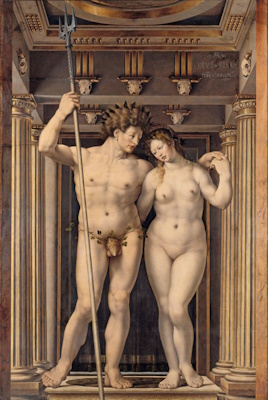
Neptune and Amphitrite
This painting depicts two frontal nudes, identified as Neptune and Amphitrite, standing in a somewhat claustrophobic domed space framed by columns. The palette is limited to varying tones of burnished gold, so that the robust and muscular figures seem almost inhabiting a niche. They incline their heads toward one another, as if in intimate conversation, while they stand in a contrapposto post on a small plinth. The artist has inscribed his signature and the date 1516 on the plinth and in the upper right corner, the name of Philip of Burgundy, his patron who is thought to have commissioned this work.
Philip played a role in Gossart’s artistic development as he invited the artist to accompany him on a trip to Rome in 1508. As art historian Maryan W. Ainsworth wrote, “His trip to Rome in the entourage of Philip of Burgundy changed the course of his career and also the direction of Netherlandish painting,” as she explained he was credited “with being the first to bring from Italy to the North the art of depicting historie and poesie with nude figures.”
Yet, Gossart’s figures depart from tradition in a number of ways: for instance, Neptune and Amphitrite were traditionally depicted being borne by four hippocampi or sometimes drawn by dolphins through the sea. Yale professor and art historian Marisa Anne Bass notes that this work became part of the Staatliche Museum’s collection in 1821, and it was only then that it “was declared a depiction of Neptune and Amphitrite, and that identification has been maintained throughout all subsequent scholarship. This assumption must have been based on the work’s apparent correlation with other depictions of the mythological couple, given that absolutely no documentation of the painting survives prior to the nineteenth century. Yet when reexamined in the light of the larger visual tradition, the accepted identification of the subject proves to be far from satisfying.” In 2016 Bass published Jan Gossart and the Invention of Netherlandish Antiquity, the first in-depth historical study of the artist, thus bringing renewed and contemporary interest to the artist.
At the same time, she re-evaluates his artistic importance, writing, “In particular, the notion that this picture...reflects a conception of antiquity grounded first and foremost in Rome fails to account for the contingencies of the local context of its creation on Netherlandish soil. By perpetuating the portrait of Gossart as a pioneer in the so-called Romanist school...scholars obscured the specificity of the Berlin painting and the artistic project that it represents. A new analysis of the work’s iconography and the intellectual milieu in which it was created suggests instead that Gossart’s painting embodies the fertile union of land and the sea and the history of the region from which it sprang: not Italy, but the Netherlands.”
Oil on oak wood - Staatliche Museum, Berlin
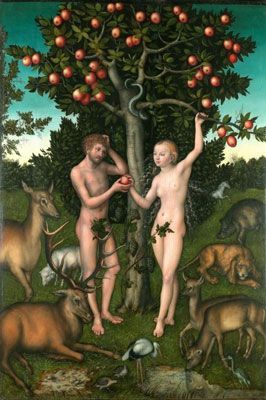
Adam and Eve
This painting depicts the Garden of Eden focusing on the moment that Eve hands Adam the apple she has just plucked from the Tree of Knowledge. The tree's trunk rises vertically between them, and the serpent coils down, its head turned toward Eve. A great number of birds and animals gather around - a stag, a hind (or deer), a sheep, a lion, a horse, a wild boar, partridges, a heron, and a stork. The tree trunk is carved with the painting's 1526 date and a serpent with bat wings from Cranach's own coat of arms. The overall effect is of a light, almost playful sensuality. Rather than conveying any sense of sin, Eve looks self-confident and beguiling while Adam is hesitant and bewildered, his state perhaps humorously reflected by the artist's pairing him with the sheep, though such to a Christian audience would have also been seen as symbolic of Christ.
Developing a distinctive style based on linear rhythm, the artist was known for his nudes and mythological subjects, as seen in Apollo and Diana (1530). As the art historian Kenneth Clark noted, his nudes evinced a "skill in combining sinuous line with shallow internal modeling" that was "unprecedented in the North." He innovatively introduced a kind of courtly style, as art critic Peter Schjeldahl wrote, "he siphoned his era's chaotic energies into wonderments of style. His re-visioning of humanity are philosophically resonant and lots of fun."
This image was influenced by Dürer's engraving Adam and Eve (1504), though, notably, Cranach has freed his work of complex symbolism and idealized imagery eschewed by the Protestant times, in essence humanizing the scene. As a friend of Martin Luther, leader of the Protestant Reformation, Cranach here depicts a subject to which the Lutherans could not object, yet, the painting, while made acceptable by its religious narrative, doesn't instruct the viewer so much as give pleasure. As Schjeldahl said, he "had a penchant for joy, undimmed in an age that turned the world upside down."
Oil on panel - The Courtauld Gallery, London
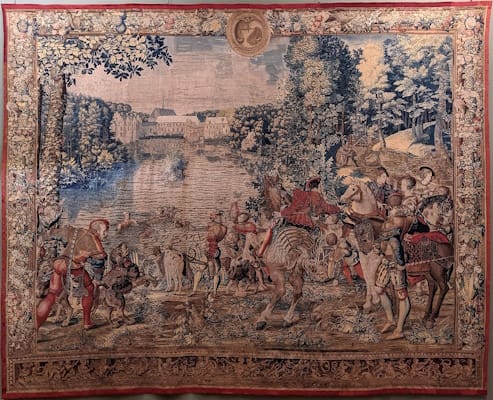
September – Scene from a deer hunt (From The Hunts of Maximilian)
This tapestry depicts an aristocratic party deer hunting. On the left a powerful man leans forward as he restrains a large hound on a leash, his dynamic figure drawing the viewer’s eye toward the center of the lake where a number of deer have been driven, as they are surrounded by a few hunters in the water. Additional leashed dogs and their handlers stand at the edge of the bank, while, to the right, a group of noblemen and ladies on horseback watch the scene. The upper half of the tapestry is given over to landscape, as the lake in the center, bordered by forest on either side, tapers upward to the Groenendael Priory. A medallion in the center of the upper border depicts the astrological sign for September, as this work is one of twelve tapestries. Each representing a month in the year, the tapestries depicted six different deer hunts in different locales. The work depicts an aspect of life in the court of the Holy Roman Emperor Maximilian I and was commissioned later by a member of his family, perhaps his grandson Holy Roman Emperor Charles V, who often visited Groendael Priory to hunt. Hunting was not only a leisure activity but reinforced social hierarchies and was believed to instill martial skills and dexterity in horsemanship. The tapestries are thought to have been designed by Bernard van Orley, pre-eminent tapestry designer of the era, and woven in a workshop in Brussels.
These tapestries were part of a long tradition of hunting tapestries, such as the Devonshire Hunting Tapestries (c. 1430-50), made in France and depicting falconry, boar, and bear hunts, as well as hunts for swans and otters. These tapestries are crowded with human figures, hunters, and groups of aristocratic men and women, but the landscape is rudimentary. In contrast the tapestries of The Hunts of Maximilian place the figures in three-dimensional space, creating an expansive landscape that incorporates vanishing point perspective.
Tapestries were an important art form that developed in Northern Europe. During the 15th century, workshops sprang up in France and the Low Countries that created tapestries for export across Europe. By the 16th century, the tapestry industry was dominated by workshops in Brussels, which created innovative and high-quality works, such as Bernard van Orley’s designs, for royal and aristocratic courts across the continent. The Hunts of Maximilian illustrate not only the adoption of Italian Renaissance styles and techniques, such as perspective, into tapestry, but also highlight the importance of tapestry as a major art form during the Northern Renaissance.
Wool, silk, silver, gold - Louvre, Paris
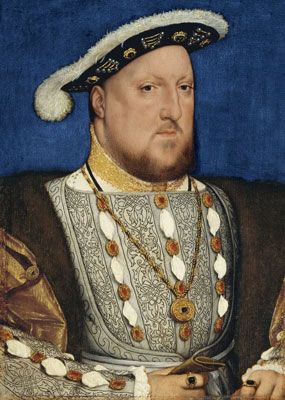
Portrait of Henry VIII of England
This three-quarters portrait depicts King Henry VIII of England, as he looks toward the viewer without making eye contact. His massive round face, the muscles in his right jaw and cheek somewhat tense, creates a sense of power, while his small tight mouth and his gaze suggest a hint of disdain and a capacity for cruelty. His role is conveyed in the regal symbols embroidered in gold on the brim of his hat, in the beautiful patterned pewter fabric, framed in rich dark fur, and ornamented with large symmetrical patterns of jewels, and the seal hung around his neck. In the foreground, his hands, wearing a large ring on each index finger, convey a sense of kinetic energy at rest. His royal bearing is distinctly evident.
Hans Holbein the Younger revolutionized portraiture, emphasizing a monumental treatment with a linear approach, while depicting precise detail, in order to convey the subject's royal bearing and a kind of psychological depth. He was trained by his father, the noted artist Holbein the Elder, and influenced by the works of the Italian Renaissance painters Andrea Mantegna and Leonardo da Vinci that he encountered in his travels to Italy at age twenty. As a result, his work was an innovative synthesis, combining Renaissance techniques of perspective and sfumato with elements of late Gothic art, most notably in portraiture. He first visited England in 1526, and quickly became much sought after as a portraitist of English nobility. His portraits of King Henry VIII, Sir Thomas More, and Thomas Cromwell have become iconic portrayals, cementing their images in the public imagination. As art historian Ellis Waterhouse wrote, his portraiture "remains unsurpassed for sureness and economy of statement, penetration into character, and a combined richness and purity of style."
Holbein's works influenced Peter Paul Rubens, Anthony van Dyck and many British artists from the 18th century on. As art historian Erika Michael noted "the breadth of his artistic legacy has been a significant factor in the sustained reception of his oeuvre."
Oil on panel - Museo Nacional Thyssen-Bornemisza, Madrid, Spain
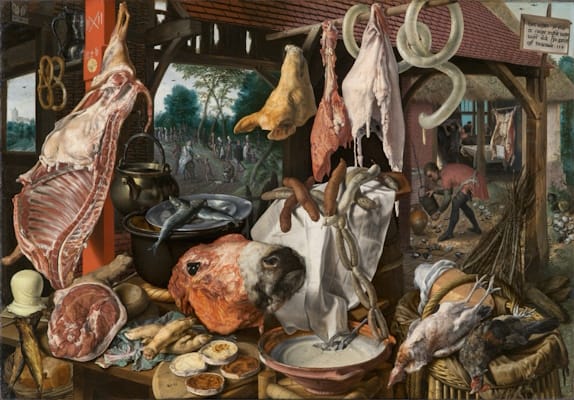
A Meat Stall with the Holy Family Giving Alms
This monumental canvas is dominated by a still life in the foreground which depicts a variety of food stuffs – from sausage links to herring to dead poultry to a large cow’s head in the lower center. This plethora shows the wealth and plenty available to the thriving Dutch middle class while simultaneously evoking the sensual appetites of material life, contrasted with the moral and religious scenes in the background.
Left of center and glimpsed through the meat stall, the Holy Family is depicted on their flight into Egypt, as Mary, mounted on a donkey and holding the infant Jesus, stops and turns to give alms. At the edge of the road, a line of villagers walks toward the church, depicted on the left, and though some turn to look at the Holy Family, most continue on their way, indifferent to both the presence of Christ and the plight of the poor. In the right background, a man draws well water, while behind him the carcass of an ox hangs in the front of a tavern where a group of men and women are carousing.
Every element of the work has symbolic and moralistic import, as even “’spiritual foods’ of kippers, pretzels, and wine are contrasted with the ‘sinful foods of oysters and mussels,” as noted by art critic James W. Singer. The two crossed kippers on a plate evoke the common symbol for Christianity, and Christ’s miracle of the “loaves and fishes,” where he fed a vast crowd with only two fish and five loaves of bread. The shells of consumed oysters, thought to be aphrodisiacs and symbolizing lust, litter the ground in the tavern scene. Visible on the right, a sign reads that there is “land for sale,” referencing greed and speculation and possibly alluding to a then-recent scandal where a charity in Antwerp sold land for profit. Singer notes, the work “is a great dialogue on the contrasts between sin and salvation,” as well as an “artistic blending of Dutch morality and Catholic piety.”
Born and raised in Amsterdam, Aertsen worked there and later in Antwerp. Initially, he painted religious scenes, but with this work he launched his invention of the monumental still life, which as art historian James Snyder wrote, “has been called the earliest example of Mannerist inversion of still life in Northern painting.” This “Mannerist inversion,” where a religious scene is depicted in the background of a genre painting, was first developed by Jan Sanders van Hemessen in works like his Parable of the Prodigal Son (1556), which foregrounded a tavern scene. Though Aertsen has been credited as one of the pioneers of still life painting, his work has been largely forgotten. Art historian Keith Moxey notes that, “Pieter Aertsen’s status as what Panofsky might have called a ‘major minor master,’ has ensured that he has occupied a peripheral position in histories of Netherlandish art. His visual vocabulary, which unites an aggressive ‘realism’ together with an Italianate gracefulness, has traditionally been regarded as one of the more eccentric aberrations of the period known as Mannerism.” Regardless, Aertsen played an important role establishing the genre of still life, as later artists such as Joachim Beuckelaer would eventually forgo the religious imagery altogether to focus on the array of material goods.
Oil on Panel - North Carolina Museum of Art, Raleigh
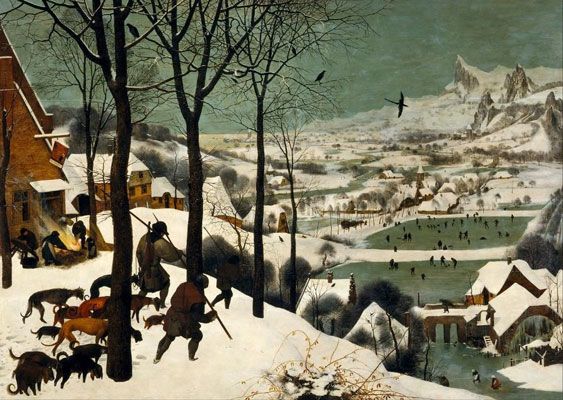
The Hunters in the Snow
This painting depicts three hunters, followed by a pack of hunting dogs, as they come home from a long day of the kill. Their dark, strongly outlined figures create a diagonal, further emphasized by the black tree trunks that surround them, drawing the viewer's attention to the village below, its roofs covered with snow. On the frozen river and large ponds, the villagers skate. Another diagonal running from middle left to lower right divides the painting between the hill and the broad expanse that fills the right half of the painting with the frozen ponds, a church spire, roads, and farmlands, rising to snow covered mountains, while overhead a black raven soars. A feeling of village life and a strong sense of community are conveyed, the harsh environment, but also its rigorous beauty, and the sense of human life, at work and at play.
Bruegel employs strong outlines, linear perspective, and repeating triangular shapes as seen in the buildings' roofs and eaves, echoed by the pinnacled mountains, to create a simple and powerful graphic design. The details and figures are realistically rendered; one can almost feel the fatigue expressed in the shoulder of the man hunched over as he takes a wide step in the snow. A single spindly vine blooming with bright yellow flowers in the foreground center is both naturalistically depicted and adds an element of brightness and a reminder of spring.
The work was created as part of a series depicting the seasons for Niclaes Jongelinck, an Antwerp merchant. Bruegel drew upon the Netherlands' calendar tradition of depicting rural labor set in a landscape, but pioneered landscape as a genre in itself, as art historian Jacob Wisse notes, "Though rooted in the legacy of calendar scenes, Bruegel's emphasis is not on the labors that mark each season but on the atmosphere and transformation of the landscape itself. These panoramic compositions suggest an insightful and universal vision of the world."
Bruegel's peasant scenes helped solidify the burgeoning genre of artists presenting moments of common everyday life. As contemporary art critic Jonathan Jones wrote, "Scenes such as The Hunters in the Snow seem to sum up the very nature of life on earth in their geographical sweep and anthropological scope. Like Shakespeare, he can capture the theatre of life." This genre informed not only the Northern European Renaissance but also influenced the artists of the Dutch Golden Age. It became a continuing trend in Western art, as seen in the 19th century works of the naturalist Jean-Jacques Rousseau, the Impressionist Camille Pissarro, and the Post-Impressionist Vincent van Gogh to name just a few.
Oil on wood - The Kunsthistorisches Museum, Vienna, Austria
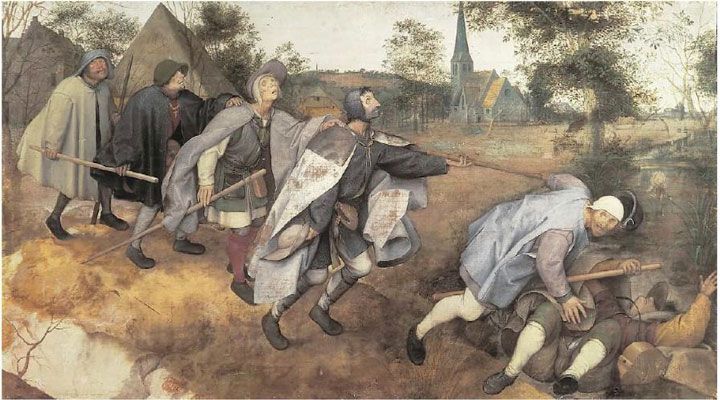
The Blind Leading the Blind
This painting shows a single procession of six blind men, gripping each other's shoulders or linked by their staffs, as they wander down a narrow path. In the background sits the realistically-depicted church of Sint-Anna and the small village of Sint-Anna-Pede. The color palette, employing grey, black, brown, and green creates a sense of austerity, while the matte and opaque effect, created by the use of distemper, brings the viewer into the same hazy experience as of the sight-challenged men. The group moves in a diagonal that tumbles forward, as the leader, rendered with remarkable foreshortening, has fallen over backwards into a ditch on the lower right, pulling the men off balance. The still upright man in the lower right twists his head toward the viewer with an unseeing gaze, as he lurches forward. The third man, bending forward on his toes, his face pointed up to the sky, tries to maintain his precarious balance. A feeling of tension, as if waiting for a row of dominos to tumble, befalls the viewer though the combined fate of the six men seems certain.
Bitter though bemused in tone, this late work, painted in the year before the artist's death, reflected the oppressive and despairing mood of the period. The Spanish government that ruled the Netherlands had established the Council of Troubles in 1567, employing the Inquisition to stamp out Protestantism. While Bruegel avoided direct political commentary, his reference to the biblical parable, in which Christ described the Pharisees as the blind leading the blind, is unmistakably reflective of the time. The men are well-dressed for their era, indicating that they are not peasants, and suggesting the lack of vision prevalent among the dominant middle class.
This work evinces, as contemporary art historian Jacob Wisse noted, "The novel and ingenious way in which Bruegel translated moralizing subjects into vernacular language." Bruegel widely influenced subsequent generations of artists and also inspired writers like the poets Charles Baudelaire, William Carlos Williams, and W.H.Auden.
Distemper on linen canvas - Museo di Capodimonte, Naples, Italy
Beginnings of Northern European Renaissance
The Italian Renaissance and the Gothic Tradition
The artworks of the Italian Renaissance and the Northern European Renaissance were very different in style and visual sensibility. During the 15th century, Italian artists were deeply inspired by the rediscovery of ancient Greek and Roman learning and art. They actively sought to incorporate elements of classical aesthetics, which focused on harmony and idealized form, into their works of art and architecture.
Meanwhile, in Northern Europe, artists drew from a pre-existing Gothic tradition of painting and manuscript illumination. Developing the medium of oil paint, they created highly detailed altarpieces and panel paintings for churches and chapels that were in line with the aesthetics of Devotio Moderna, a late medieval religious movement that emphasized empathetic piety, where worshippers could see the divine in the everyday; the realism and illusionism in works by artists such Jan van Eyck brought the divine into daily life and allowed viewers to directly identify with religious figures.
The Burgundian Court
During the 15th century, the dukes of Burgundy ruled large territories across Northern Europe that included parts of present-day France (the region known as Burgundy), Luxembourg, Belgium, and Holland. Due to the wealth and political power of the dukes, the Burgundian court was one of the most important sites of artistic production in Northern Europe. Because Burgundian court was itinerant, there was with no fixed capital; instead, the dukes maintained various courts throughout their territories and thus stimulated artistic production throughout the region. Within these ducal holdings, major trade cities in the Low Countries such as Bruges and Brussels served as particularly important artistic hubs and favored destinations for the dukes.
The Burgundian dukes believed that patronage of the arts was crucial to demonstrating princely magnificence and power. The variety of artistic production at the court was stunning, as the dukes commissioned artworks across a wide range of media, including tapestry, goldwork, sculpture, illuminated manuscripts, and painting. While some of these artworks drew from older, pre-existing Gothic traditions, such as the production of lavishly illustrated books of hours, other works, such as paintings featuring nude figures and mythological subject matter, turned to newer trends from Italy. Naturally, talented artists such as Jan van Eyck were drawn to the court, which served as model of artistic patronage for other rulers across Europe. Burgundian prominence in the arts would last until 1477, when the duchy of Burgundy reverted to France and the Low Countries were ceded to the Holy Roman Empire through the marriage of Mary of Burgundy to the future Holy Roman Emperor Maximilian I.
Illuminated Manuscripts and the Limbourg Brothers
The International Gothic style of manuscript illumination represented the pinnacle of a long tradition. During the medieval period most books had been rare manuscripts, made by hand with vellum pages that contained brightly inked illustrations accentuated with gold and silver, which appeared "illuminated." Made by monks in scriptoriums, these manuscripts were primarily religious, including Bibles like the noted The Book of Durrow (650-700) or The Book of Kells (c. 800). Later volumes included bestiaries like The Westminster Abbey Bestiary (c. 1275-90), drawing upon classical Greek and Biblical accounts of fantastic beasts, or books of prayer like The Book of Hours of Jeanne d’Evreux (c. 1324-28).
The International Gothic style was exemplified by the Dutch miniaturist brothers Herman, Paul, and Johan Limbourg who became renowned for their Très Riches Heures du Duc de Berry (c. 1412-16), an illuminated book of prayers to be said during the canonical hours. It was one of the earliest illuminated manuscripts made by known artists rather than monks. Scenes of contemporary life dominated the work of 130 illustrations, half of which were miniatures depicting scenes of court life, agricultural labor, and military expeditions, rendered in jewel-like colors.
Tapestry in the North
Tapestry was an important form of artistic production in Northern Europe, particularly in Northern France and the Low Countries. Aside from their decorative purposes—used to adorn the walls of castles and churches—tapestries were mobile, so they could be easily transported, and provided additional insulation from the elements. Tapestries were traditionally valued over painting during the Northern Renaissance as they used costly materials, such as dyed wool, silk, and gilt metallic thread, as well as a great amount of labor. To make a tapestry, an initial design, called a “cartoon” would be created by an artist. This design would then be taken to a workshop, where it would be woven by hand on a loom. During the 15th and 16th centuries, workshops in Northern Europe produced numerous tapestries that were exported across Europe.
Tapestries from the 15th century often depicted biblical, historical, or hunt scenes and featured complex narratives and iconography. Stylistically, these works, drawing from Gothic tradition, emphasized pattern and line, rather than volume in the rendering of figures and spaces. Famous examples of these late-Gothic tapestries include the famous Lady and the Unicorn series that were designed in Paris and woven in Flanders, c. 1500, in the mille-fleurs or “thousand flowers” style. However, artists began to introduce forms and subject matter from the Italian Renaissance in the 16th century. For example, Bernard van Orley’s Hunts of Maximilian, a set of twelve tapestries made for the Holy Roman Emperor Maximilian I made c. 1528-33, created a new style of tapestry that incorporated Italianate elements such as the use of perspective and a volumetric rendering of his figures.
Jan van Eyck and Robert Campin: Early Northern Renaissance Oil Painting
The artists Robert Campin and Jan van Eyck played important roles developing the detailed and illusionistic style of oil painting that would characterize Northern Renaissance art during the 15th century. Their work, drawing from late Gothic styles and art from the Burgundian court, was also influenced by the Devotio Moderna movement, which emphasized empathetic piety and the emotional response of the viewer; the emphasis on detail and realism in their paintings served in part to heighten the emotional impact of their works. The style developed by van Eyck and Campin was extremely influential until the end of the 15th and early 16th centuries, when a new generation of artists would incorporate traditional styles with elements taken from Italy, such as the introduction of classical motifs and depictions of the nude body.
Influenced by the Limbourg brothers, Robert Campin pioneered the use of oil painting that characterized the North European Renaissance. Only a handful of works can be certainly attributed to him, as he seldom signed his work, a common practice in the Middle Ages. As subsequent scholarship has identified him as the Master of Flémalle, his masterwork is considered to be the Mérode Altarpiece (1427). Like most International Gothic artists, he primarily painted religious subjects but his contemporary settings depicting ordinary activities, simultaneously accurate in observation and symbolic in meaning, initiated the Renaissance approach. Rogier van der Weyden, an important artist, was first trained in his workshop.
Jan van Eyck, who was Campin’s contemporary, so mastered oil painting that historian Giorgio Vasari was to erroneously credit him with the invention of the medium. Little is known of van Eyck's training or artistic background, as he first appears in records in 1422 as a painter for John III the Pitiless, ruler of Holland. We do know that van Eyck was versed in Greek and Latin, the mark of the educated class. Subsequently, he became the court painter for Philip, Duke of Burgundy until 1429. His pioneering masterpiece The Ghent Altarpiece (1431) launched the Renaissance in Northern Europe with its oil painting and realism. Subsequently he pioneered both self-portraiture with Portrait of a Man (1433) and portraiture with his Arnolfini Portrait (1434). His technique and style influenced his contemporaries Petrus Christus, Hans Memling, and van der Weyden.
Van Eyck was the only 15th-century Northern European artist to sign his works. He sometimes used the phrase "I Jan van Eyck was here," but more often used his motto "ALS IK KAN," meaning "As I can," a pun upon his name and the Dutch word for art. His motto, like that of the Italian Renaissance architect Leon Battista Alberti's, "A man can do all things if he will," reflected a distinctly Renaissance view of the artist as a divinely inspired genius.
The Printing Press and Print Making
The advent of the printing press, invented by Johannes Gutenberg c. 1440, made sacred texts accessible to any literate individual, and allowed intellectuals to publish their own writing. Printing had a revolutionary impact on the era but particularly in Northern Europe. Gutenberg's Bible (1455), the first German version, made the sacred text widely available, and, though printed in Latin, translations into English and German followed in the 1520's. The new accessibility of the text corresponded with rising Protestant belief that an individual could have a personal relationship with God, without need of a mediating Pope or priest. Many of the first books were religious texts, often illustrated by Northern artists.
Aside from the development of the printing press, the Northern Renaissance also witnessed the development of print making. Engravings were first produced in Germany in the 1430s, but would become a major artistic medium after 1470, when artists such as Martin Schongauer, a goldsmith and printmaker, and later, Albrecht Dürer helped develop engraving as a major art form. In addition to the rising popularity of engraving, the technique of etching was developed in Germany around 1500. While less popular than engraving, many artists nonetheless experimented with the medium, especially those from the Danube School in Germany or School of Fontainebleau in France.
With the growing popularity of printed media, artists began to make individual prints, as well as series of prints, for the art market. These included both secular and religious content, sometimes derived from pre-existing designs, such as paintings, but often were created explicitly as prints. Northern Europe, particularly Antwerp, served as an important hub of print production. The establishment of printing houses, such as Aux Quatre Vents run by Hieronymus Cock, allowed for the mass production, publication, and dissemination of printed artworks. As an early form of mass-media, prints thus served as an important way to spread knowledge and new artistic styles across not only Europe, but also across the globe.
German Renaissance and Albrecht Dürer
During the late 15th century, Germany emerged as an important region for artistic production, as artists developed unique regional styles that drew from both the Low Countries and Italy, but also incorporated local traditions.
Albrecht Dürer, a master printmaker, draughtsman and painter, is the most notable artist of the German Renaissance. The artist made two trips to Italy, the first in 1494, and the second in 1505; he played a major role bringing styles and imagery from the Italian Renaissance to the North. Dürer’s work reflects a deep engagement with the philosophical and artistic currents of Renaissance Italy and Venice, as seen in his altarpiece Feast of the Rose Garlands (1506), which reflects his interest in Venetian color. His engravings such as Adam and Eve (1504) also reflect the Italian humanist celebration of the ideal human form and draw from classical models. Dürer was interested in humanist philosophy and maintained a lifelong friendship with the German humanist Conrad Celtis, who promoted a study of German antiquity. Dürer's Four Books of Human Proportion (1532) and his work of geometric theory, Underweysung der Messung (1525), were the first such works by an artist from Northern Europe and included a scientific discussion of perspective.
While Dürer engaged directly with antiquity and Italian Renaissance ideas, other German artists, such as Matthias Grünewald, worked in style derived from late Gothic painting but included contemporary technical advances in oil painting to create vivid and expressive forms. His Isenheim Altarpiece (1512-16), made for the Monastery of St. Anthony, illustrates how traditional styles continued to flourish in Germany well into the 16th century.
German artists also contributed to the development of landscape as a genre. Albrecht Altdorfer, who worked in the imperial city of Regensburg, was part of a group of artists known today as the Danube School. He and his colleagues, such as Wolf Huber, created paintings and prints depicting the local forests and countryside. For example, in Altdorfer’s Saint George (1510), the dense, leafy forest plays a prominent role in the composition, while the religious scene is almost secondary. Altdorfer also had important imperial patrons; his large-format painting Battle of Alexander at Issus (1529), which features a chaotic scene of warfare against the backdrop of craggy mountains and a distant landscape, was made for William IV, Duke of Bavaria.
Artists of the German Renaissance were deeply affected by the Reformation. Lucas Cranach the Elder was another artist who engaged with antiquity and new ideas from the Italian Renaissance. For example, many of his works made for aristocratic patrons depict subject matter from classical mythology and prominently feature nudes, such as his painting Apollo and Diana (1530). But with the spread of Lutheranism, Cranach began to produce portraits of Martin Luther and other Protestant leaders. He also developed new religious subject matter that followed Luther’s guidance on images, such as his painting Law and Gospel (ca. 1529). Hans Holbein the Younger was another noted artist whose career was directly impacted by the Reformation. In 1526, he left the city of Basel, where he produced his iconic Dance of Death woodcut series (c. 1526), due to the iconoclastic religious climate. He traveled to England, where he worked primarily as a portraitist. Although he would return to Basel, he eventually settled in England, where he worked at the court of Henry VIII and produced major works such as The Ambassadors (1533).
Patronage of the Merchant Class
Unlike the Italian Renaissance where a few wealthy patrons, like the ruling Medici family in Florence or the Pope in Rome, commissioned most of the era's major artistic works, the Northern Renaissance primarily produced art for a prosperous merchant class. The growth of urban centers, such as Antwerp, led to the development of art markets where prints, portraits, and paintings, all of which could be displayed in private homes, were sold to great demand. While some artists, such as van Eyck or Dürer, worked for princely patrons, they also derived much of their income from wealthy bourgeois clients and reached much broader public audience than their Italian counterparts.
The Protestant Reformation
In 1517, Martin Luther wrote the Ninety-Five Theses, which attacked the excesses and corruption of the Roman Catholic Church. His publication sparked the Protestant Reformation, which promoted a new interpretation of Christianity that was focused on scripture and faith alone and no longer required the mediation of the Church. While the Reformation began in Germany, it quickly spread throughout Northern Europe. Many regions witnessed conflict between Protestants and Catholics, especially as regional rulers either adopted Protestantism or stood in defense of the Catholic Church.
Naturally, the Reformation deeply influenced the production of artwork across Europe. Certain regions experienced iconoclasm, where Protestants destroyed religious artworks that were deemed as idolatrous, such as portraits of saints. Artists were thus forced to negotiate the tumult of the period with various strategies, such as developing new, secular types of painting, which included scenes of daily life or still-lifes, or focusing on Protestant subject matter. For example, Lucas Cranach the Elder worked closely with the main figures of the Reformation to create new works. He produced portraits of Martin Luther, with whom he was friends, as well as scenes Protestant religious themes, such as “Christ Blessing the Children.” His art, which pointed out the failings and flaws of human behavior, was received favorably by both the Protestant public and the movement's leaders.
Concepts and Styles
Northern Renaissance Humanism
While Italian humanism focused on the study of classical Greek and Roman texts and emphasized individual man's importance in the world, Northern European humanism was primarily Christian in nature; it applied the methods used to study the classics to the analytical study of the bible and emphasized the foundations for leading a Christian life. The development of the printing press allowed for the wide dissemination of works by leading thinkers such as the Desiderius Erasmus, a classical scholar and Catholic priest known for his views of religion and new translations from Greek and Latin of New Testament, and Conrad Celtis, a poet, scholar, and historian who stimulated classical learning in Germany and promoted the study of German antiquity.
Humanism played a major role in shaping artistic production in the North, as artists themselves studied humanist literature and created works for educated patrons who valued humanistic erudition. For example, Erasmus’s humanistic texts influenced artists such as Pieter Bruegel, whose print series The Seven Virtues (1559-60) was inspired by Erasmus’s Enchiridion (1501). Erasmus also maintained personal connections with important artists of the day, such as Quentyn Massys, Albrecht Dürer, and Hans Holbein the Younger, who painted portraits of him. Celtis had a strong influence on German artists, especially Albrecht Dürer, a lifelong friend and working colleague. Together, they produced works such as the illustrated Quatuor Libri Amorum (1502), which feature woodcuts by Dürer.
Exchange Between the North and South
During the early 15th century, artists in Northern Europe developed regional styles that drew from the Gothic tradition and Burgundian court culture. At the same time, artists in Italy developed distinctive styles and subject matter based on the rediscovery of antiquity. However, there was also extensive artistic and economic exchange between Northern Europe and Italy during this period. Oil paint, which was developed in the North and was closely associated with artists such as van Eyck, slowly began to replace tempera as the medium of choice for artists in Italy. Works such as the Portinari Altarpiece (c. 1475-78), which was made in Florence by the Flemish painter Hugo van der Goes, further highlight the artistic connections between the two regions.
By the late 15th century, it was common for artists from the North, such as Albrecht Dürer, to travel to Italy to study the works of antiquity and the different regional styles. In the Low Countries, a group of artists, which included Jan Gossaert, Maarten van Heemskerck and Pieter Coecke van Aelst, were known as the “Romanists” for their introduction of classicizing motifs and Italianate forms; their unique blending of Northern and Italian motifs created a new type of painting, which by the 1520s would replace the older styles first developed by van Eyck and Campin. In France, King Francis I was so enamored by Italian art that he invited the artists Rosso Fiorentino and Benvenuto Cellini to his court, where they would work with Flemish and native French artists to design royal works of art.
Altarpieces and Devotional Works
Altarpieces were some of the most important types of artwork created during the Northern Renaissance. They were commonly created in a multiple-panel format known as a diptych (altarpieces with two panels), triptych (with three panels) or polyptych (with four or more panels) so that the side panels could be folded inward, essentially covering the paintings of the inner panels. While the outer panels would often be painted with simpler imagery, often in grisaille, the main inner panels featured detailed and lavishly painted religious scenes. Triptychs and polyptychs would usually be stored closed, with the inner scenes covered, but then opened for Mass and other special occasions, such as Saint’s Day celebrations.
Artists including Hans Baldung Grien, Dierec Bouts, Hugo van der Goes, Hans Memling, Rogier van der Weyden, Jan van Eyck, and Matthias Grünewald executed their most noted works as large-scale altarpieces. Most of these works were commissioned for or by monasteries or churches. In some altarpieces, portraits of the donors were also included, as seen in Hugo van der Goes's Portinari Altarpiece (c. 1475), Portrait of Tommaso Portinari (c 1470), and Portrait of Maria Portinari, (c. 1470-72).
While these large altarpieces were destined for semi-public spaces such as churches or aristocratic chapels, artists also made works for private devotion. These were much smaller in size, often portable in nature, and came in a variety of formats, including single panels, diptychs or triptychs, such as Jan van Eyck’s beautifully painted Dresden Triptych (1437). These paintings, which were commissioned for the homes of wealthy members of the banking or merchant classes, were intended to encourage private prayer and contemplation in daily life. Like the larger altarpieces of the period, many of these devotional works feature portraits of the donor, such as Hans Memlings Diptych of Maarten van Nieuwenhove (1487).
The Rise of Printmaking
The Northern Renaissance is particularly noted for its rich production of prints—woodcuts, engravings, and etchings. Because of its reproducibility and small format, print was able to reach broader audiences and thus, served as an important medium for the spread of artistic ideas and imagery. Notable artists such as Martin Schongauer, Pieter Bruegel, Hans Holbein the Elder, Lucas Cranach the Elder, and Albrecht Dürer understood the power of printmaking and produced numerous original designs specifically for the medium.
Martin Schongauer was the most important Northern printmaker before Dürer. Originally trained as a painter, Schongauer created engravings primarily of religious scenes, such as his Temptation of St. Anthony (1470-75), but also peasant life and ornament designs. Schongauer is credited as one of the first artists to have perfected the technique of engraving, which had originally been developed by goldsmiths, and his prints are noted for their complexity of detail, attention to realism, and textural variety.
Dürer, a master of both woodcut and engraving, revolutionized the potential of printmaking as an independent medium for art, developing its dramatic and tonal capabilities, and exploring new imagery. His various woodcut series like The Apocalypse (1498) and the Large Woodcut Passion (c. 1497-1500), based on religious narratives, launched his fame throughout Europe. Subsequently, he made individual prints like his engraving Adam and Eve (1504) and series of images called his Meisterstiche (master engravings) that included prints such The Knight, Death, and the Devil (1513). As art historian Jacob Wisse noted of his prints, "Their technical virtuosity, intellectual scope, and psychological depth were unmatched by earlier printed work."
Bruegel came from a family of four generations of printmakers and artists, and from 1555 to 1562, worked primarily with Aux Quatre Vents (At the Four Winds), an Antwerp publishing house. He designed engravings that often translated proverbs, morals, and parables into contemporary scenes, as seen in his engraving Big Fish Eat Little Fish (1557). Visual treatments of proverbs had been popular, dating back to early 15th century books of the hours. Often the interest in proverbs combined an appreciation of the common sense of the people of Northern Europe with moralistic purpose.
Hans Holbein the Younger's work often served a moralistic purpose as well, as seen in his famous series of woodcuts, The Dance of Death (1526), depicting Death's arrival in various scenes where ordinary people are engaged in everyday activities. Such works served as memento mori, reminders of mortality, urging people to live a virtuous life.
Cranach the Elder, closely associated with the Protestant Reformation due to his close friendship with Martin Luther, created prints portraying Luther and his family, as well as other Protestant leaders. His other artwork often illustrated Protestant themes printed in pamphlets and distributed to proselytize the faith.
Portraits
Portraiture was an economic mainstay for many Northern European artists, and the mastery of oil painting allowed for artistic virtuosity, precise realism, and psychological portrayals (there is a reason why Willem de Kooning in the 20th century famously said "Flesh is the reason oil painting was invented"). Rogier van der Weyden, Petrus Christus, Hans Holbein the Younger, Lucas Cranach the Elder, Hans Memling, Jan van Eyck, and Albrecht Dürer were all noted portraitists. The masterworks of Van Eyck and Dürer included self-portraits that became foundational to the form in technique and sensibility. Holbein the Younger and Cranach the Elder made iconic portraits of the notable leaders of the day: Holbein portrayed the English court, and Cranach the leaders of the Reformation. Christus created portraits like his Portrait of a Carthusian (1446), showing an anonymous monk, and his Isabel of Portugal with St. Elizabeth (1457-60), as well as Portrait of a Young Girl (c. 1470). Rogier van den Weyden's portraits like his Portrait of a Woman (1460) were noted for their sculpted facial features and realistic expression.
The Invention of New Genres
The Northern European Renaissance was responsible for introducing various new genres that would become long-lasting motifs in Western art. Due in part to the Reformation, which rejected certain types of religious imagery and the rise of wealthy merchant class, there was enormous growth in the market for secular painting. While landscape and still-life had their origins in religious painting, over the course of the 16th century, they grew into their own separate genres.
Joachim Patinir pioneered the development of landscape painting in works like Flight into Egypt (1516-17), which featured religious scenes set within magnificent and fantastic landscapes of mountains, farmland, forests, and bodies of water. The taste for this type of “world landscape” grew, and over time, the paintings lost their religious imagery. Bruegel also played a major figure in developing landscape with his works such as Winter Landscape with Skaters and Bird Trap (1565), which present a more realistic, observed landscape compared to the earlier versions by Patinir.
With their attentive rendering of consumer goods, Pieter Aertsen’s paintings pairing market stalls with religious scenes helped establish a taste for still-life paintings. Over time, artists such as Joachim Beuckelaer would create compositions forgoing the religious figures altogether and focus solely on market and kitchen scenes. Additionally, Albrecht Dürer's detailed and observant depictions of flora and fauna, such as his Large Piece of Turf (1503) or his Young Hare (1502), informed the development of still-life painting, especially depictions of the natural world.
Lastly, depictions of daily life, especially scenes of peasants in the countryside, became popular during the 16th century. Bruegel played a key role in developing this type of artwork, also known as genre painting, as demonstrated by The Peasant Dance (1568). He became so associated with this subject matter that he was dubbed "peasant Bruegel."
Later Developments - After Northern European Renaissance
By the 1580s, artistic tastes shifted as Mannerism, which was first developed in Italy, spread throughout Northern Europe. A new generation of artists, such as Hendrick Goltzius, Cornelis Cornelisz van Haarlem, and Adriaen de Vries, would draw from new Italian trends to develop a distinctive style of Northern Mannerism that featured sinuous, elongated bodies and centered on the concept of artifice. Aside from these changing tastes, political events such as the outbreak of the Eighty Years’ War in 1568, in which the Low Countries fought for independence from their Spanish Habsburg rulers, greatly affected the production of artwork in the Low Countries. The second half of the 16th century also witnessed the development of new artistic hubs, most notably Prague, the seat of the Holy Roman Emperor Rudolf II.
In the following century, artists from the Dutch Golden Age drew inspiration from the techniques and genres developed during Northern Renaissance. In particular, portraiture, genre, landscape and still-life became major categories of painting that played an important role in the art market. For example, artists such as Adriaen Brouwer and David Teniers the Younger established careers as peasant painters in the model of Pieter Bruegel.
Additionally, each Northern European Renaissance artist went on to have a long-lasting influence. Matthias Grünewald's work influenced the Expressionists and New Objectivity artists like Otto Dix and George Grosz, as well as Pablo Picasso, and the Surrealist Max Ernst. Jan van Eyck was foundational to the works of the Pre-Raphaelites, as Hieronymus Bosch's work was to Surrealists like Salvador Dalí and Joan Miró. Hans Holbein the Younger's portraiture influenced Anthony van Dyck, Peter Paul Rubens, and British portraiture beginning in the 1700s. Bruegel's peasant genre launched the painting of everyday life as a trend in Western art, found in the subsequent movements of Realism (and the many strands of it to this day), Naturalism, Impressionism, and Post-Impressionism, to name a few.
The innovations of the Northern European Renaissance so informed Western art, that art historian Joseph Leo Koerner, referencing the realism and self-staging of Dürer and van Eyck and the idiosyncratic vision of Bruegel and Bosch, has argued (rather boldly) that they, rather than the Italian Renaissance artists, laid the groundwork for modern art.
Useful Resources on Northern European Renaissance
-
![BBC Northern Renaissance The Birth of the Artist]() 277k viewsBBC Northern Renaissance The Birth of the ArtistOur PickWith Joseph Leo Koerner / BBC
277k viewsBBC Northern Renaissance The Birth of the ArtistOur PickWith Joseph Leo Koerner / BBC -
![The Road to van Eyck]() 12k viewsThe Road to van EyckOur PickMuseum Boijmans Van Beuningen / Friso Lammertse and Stephan Kermperdick
12k viewsThe Road to van EyckOur PickMuseum Boijmans Van Beuningen / Friso Lammertse and Stephan Kermperdick
-
![Bruegel: Unseen Masterpieces at the Royal Museums of Fine Arts of Belgium]() 46k viewsBruegel: Unseen Masterpieces at the Royal Museums of Fine Arts of Belgium
46k viewsBruegel: Unseen Masterpieces at the Royal Museums of Fine Arts of Belgium -
![Renaissance Revolution: The Garden of Earthly Delights]() 189k viewsRenaissance Revolution: The Garden of Earthly DelightsOur PickBBC
189k viewsRenaissance Revolution: The Garden of Earthly DelightsOur PickBBC -
![Hieronymus Bosch Art Documentary with Brian Sewell]() 446k viewsHieronymus Bosch Art Documentary with Brian Sewell
446k viewsHieronymus Bosch Art Documentary with Brian Sewell
-
![Reflections: Van Eyck and the Pre-Raphaelites]() 18k viewsReflections: Van Eyck and the Pre-RaphaelitesTalk by Susan Foister / National Gallery London
18k viewsReflections: Van Eyck and the Pre-RaphaelitesTalk by Susan Foister / National Gallery London -
![Dürer and Beyond: European Drawings in the Metropolitan Museum of Art 1400-1700]() 37k viewsDürer and Beyond: European Drawings in the Metropolitan Museum of Art 1400-1700Talk by Stijn Alsteens and Freyda Spira, Thomas DaCosta Kaufmann, and Maryan Ainsworth
37k viewsDürer and Beyond: European Drawings in the Metropolitan Museum of Art 1400-1700Talk by Stijn Alsteens and Freyda Spira, Thomas DaCosta Kaufmann, and Maryan Ainsworth -
![Bruegel The Harvesters]() 110k viewsBruegel The HarvestersThe Met
110k viewsBruegel The HarvestersThe Met -
![Albrecht Dürer: The Hare, 1502]() 22k viewsAlbrecht Dürer: The Hare, 1502Albertina Museum
22k viewsAlbrecht Dürer: The Hare, 1502Albertina Museum -
![The Dürer Rhinoceros: Masterpieces of the British Museum]() 86k viewsThe Dürer Rhinoceros: Masterpieces of the British MuseumOur PickArt Documentaries
86k viewsThe Dürer Rhinoceros: Masterpieces of the British MuseumOur PickArt Documentaries -
![Discovering the Dürer Cypher]() 19k viewsDiscovering the Dürer CypherOur PickTalk by Elizabeth Maxwell-Garner / Rebecca Bryan Art Gallery
19k viewsDiscovering the Dürer CypherOur PickTalk by Elizabeth Maxwell-Garner / Rebecca Bryan Art Gallery





























